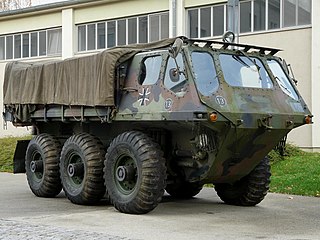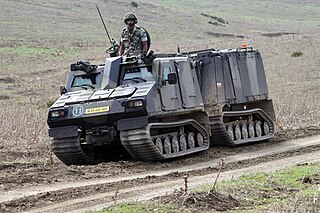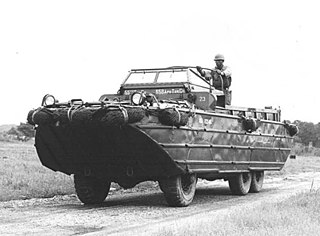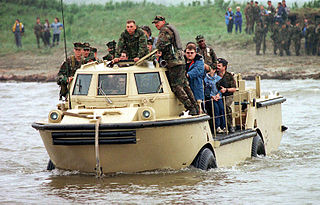 W
WThe Stalwart, formally classified by the British Army as Truck, High Mobility Load Carrier (HMLC), 5 Ton, 6 x 6, Alvis/Stalwart and informally known by servicemen as the Stolly, and by former RCT as the Stally is a highly mobile amphibious military truck. Built by Alvis between 1963 and 1971. They served with the British Army from 1964 until 1993.
 W
WKunduz or AZMİM, is a Turkish tracked amphibious combat engineering armoured bulldozer.
 W
WLARC-LX, or as it was originally designated BARC is a welded steel-hulled amphibious cargo vehicle.
 W
WA beach armoured recovery vehicle (BARV) is an armoured recovery vehicle used for amphibious landings.
 W
WThe Bronco All Terrain Tracked Carrier (ATTC) is a twin chassis multi-purpose tracked carrier articulated vehicle jointly developed by ST Kinetics and the Defence Science & Technology Agency (DSTA) for the Singapore Army. The variant which was in service with the UK armed forces is known as the WARTHOG.
 W
WThe BvS 10 is an All Terrain Armoured Vehicle produced by BAE Systems Land Systems Hägglunds of Sweden. This vehicle, referred to as the All Terrain Vehicle (protected) - ATV(P) or Viking by the UK forces, was originally developed as a collaboration between industry - Hägglunds Vehicle AB - and the UK Ministry of Defence (MoD) on behalf of the Royal Marines.
 W
WThe DUKW is a six-wheel-drive amphibious modification of the 2 1⁄2-ton CCKW trucks used by the U.S. military during World War II and the Korean War.
 W
WThe Europa Jeep was a multinational military vehicle project that was ultimately abandoned before it could enter production.
 W
WThe Fiat 6640A is an Italian wheeled amphibious armoured vehicle produced from the early 50s to the 80s for the Italian government. The 6640A carries a crew of two, protected by 4 mm thick armour, and is powered by a six-cylinder diesel engine providing a top speed of 90 kmh.
 W
WThe Ford GPA 'Seep' was an amphibious version of the World War II Ford GPW jeep. Unlike the jeep, the seep was not a successful design; it was considered too slow and heavy on land, and lacked sufficient seagoing abilities in open water. The design features of the much larger and more successful DUKW amphibious truck were used on the GPA.
 W
WThe GAZ-46, army designation MAV, is a Russian-made light four-wheel drive amphibious military vehicle that entered service in the 1950s and has been used by many Eastern Bloc allied forces since. During the Second World War Canada, Britain and the US forwarded large quantities of military materials to Russia. Among those were jeeps, trucks, and amphibious vehicles like the 6x6 DUKW and the 4x4 Ford GPA. The latter were used to help men and equipment get across the many rivers of Eastern Europe and combat the Germans. Seeing merits of such vehicles, after the war, Russia decided to develop two similar vehicles, using domestic automotive parts, the BAV, an equivalent of the DUKW, and the MAV, an equivalent of the Ford GPA.
 W
WLandwasserschlepper was an unarmed amphibious tractor produced in Germany during World War II.
 W
WLARC-V, is an aluminium-hulled amphibious cargo vehicle capable of transporting 5 tons. It was developed in the United States during the 1950s, and is used in a variety of auxiliary roles to this day.
 W
WThe M3 Amphibious Rig is a self-propelled, amphibious bridging vehicle that is used for the projection of tanks and other vehicles across water obstacles.
 W
WThe PTS is a Soviet tracked amphibious transport. PTS stands for Plavayushchij Transportyer - Sryednyj or medium amphibious transport vehicle. Its industrial index was Ob'yekt 65.
 W
WThe Amphibious Truck "Su-Ki" was a World War II Japanese military vehicle manufactured by the Toyota Motor Co., Ltd. It entered service in 1943 and was used by Japanese forces in the Pacific during World War II.
 W
WThe Terrapin was a British-manufactured amphibious transport vehicle of the Second World War. It was first used in 1944 at Antwerp during the Battle of the Scheldt.
 W
WThe special Type 4 Launch Ka-Tsu was a Japanese amphibious landing craft of World War II. The first prototype was completed in late 1943 and trials were conducted off Kure in March 1944.
 W
WThe Panhard Véhicule Blindé Léger, also known by its acronym Panhard VBL or simply VBL, is a French wheeled 4x4 all-terrain vehicle built by Panhard. The vehicle is offered in various configurations, and was designed to combine the agility of the Peugeot P4 liaison vehicle with adequate protection against small arms fire, artillery fragments, mines and NBC weapons. Produced between 1985 and 2010, the vehicle has been used by the French Army and other European, African and Central American armies in various conflicts since the 1980s.
 W
WThe VW Type 128 and 166 Schwimmwagen were amphibious four-wheel drive off-roaders, used extensively by German ground forces during the Second World War. The Type 166 is the most numerous mass-produced amphibious car in history.